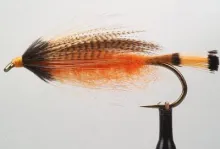This fly uses a special technique where a strand of floss and a strand of tinsel is twisted together before the combo is wound on the hook shank.
This fly uses a special technique where a strand of floss and a strand of tinsel is twisted together before the combo is wound on the hook shank. The rope - if twisted regularly enough - will form a nice segmented body with built in ribbing. The name of the fly is divised from this technique and the fact that it's made mainly from yellow materials. A similar fly without the twisted body is Orange Twist.
| Hook | 6-2 Bartleet salmon fly hook |
| Thread | Yellow/white and Black |
| Tag | Narrow flat silver tinsel |
| Body | Oval silver tinsel and yellow floss twisted |
| Thorax | Red flash dubbing |
| Hackle | Yellow hen hackle |
| Head | Black |
- Cover the hook shank with a smooth layer of light thread. Let the thread hang down to reach the hook point
- Tie in a strip of narrow silver tinsel and wind it to reach a point above the point of the barb and back
- Tie down and cut surplus
- Take a strand of yellow floss and a similar strand of oval silver tinsel
- Tie in both at the tag
- Wind the thread forwards, form a smooth foundation of thread for the body
- Twist the floss and tinsel counterclockwise using hackle pliers.
- The twist should form a tight and even rope
- Wind the rope forwards in close and even turns to a point 1/4 shank length behind the hook eye
- Tie down and cut surplus
- Dub some red flash dubbing on the thread and form a short, dense thorax
- Tie in a yellow hackle, tip first and hackle stem upwards
- Wind the hackle clockwise in wet fly style, folding it over and stroking barbs to the rear of the hook
- 2-3 turns will suffice depending on the hackle
- Tie down and cut surplus
- Whip finish the light thread and tie in the black
- Form a nice, small head from black tying thread
- Whip finish and varnish
- Log in to post comments










John,
When I mak
John,
When I make floss bodies of any kind, I don't treat them. But on the other hand I rarely fish them, and the problem is that they are fragile. Many tyers who tie synthetic floss bodies on fishing flies will coat them for durability. You can "fuse" them with acetone (it kind of melts some types of synthetic floss) or use varnish or some light curing resin for the purpose.
Martin
Silk fly bodies, eit
Silk fly bodies, either floss or thread,do you treat with any cement or coating?